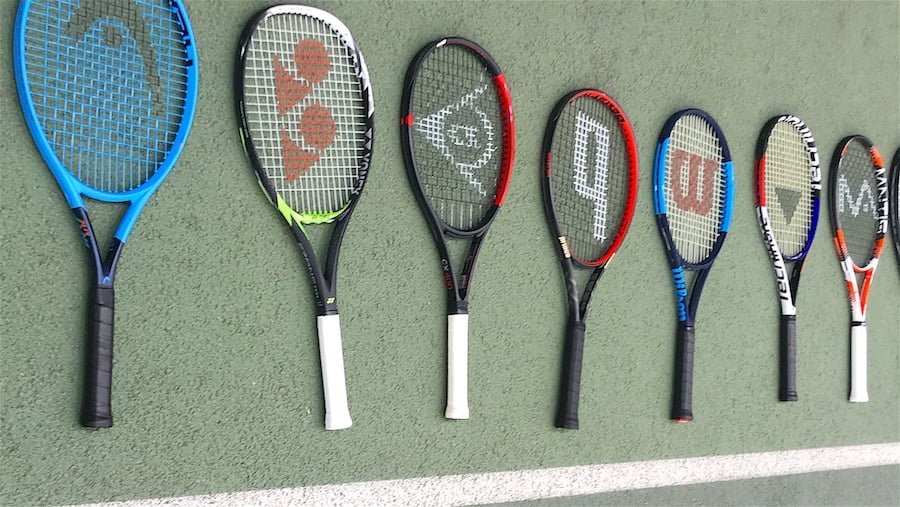Racket parts
Head or bow
It is oval in shape, where we have the string and it has two faces, through which we can hit interchangeably. The size of the head of the racket influences the power you will deliver. It is usually classified as:
Mid-size: up to 95 square inches = 613 square cms of surface
Mid-plus: up to 105 square inches = 677 square inches of the surface.
Super Mid-Plus: up to 115 square inches.
Over-size: Over 115 square inches.
Rigging
It is normally made up of one or two pieces of string that are attached to the racket and intertwined with each other.
Neck or heart
The part that joins the head with the fist and where the racket is usually held with the left hand, of a right-handed player, to change the handles and be in a balanced position while waiting for the opponent’s blow. On the inside, there is usually information about weight, balance, string pattern, recommended string tension, head size, length, power level, etc.
Fist
It is where the racket is held with the dominant hand, right for right-handed and left for left-handed. Regarding the thickness of the fist, they usually come in different thicknesses depending on the size of the player’s hand holding the racket.
Frame or cane
It is what makes up the body of the racket and usually has different “profiles”. These profile designs come based on the type of player who is going to play with it.
Fist heel
It is the back of the racket where it usually has the logo of the brand of it and you could put it upright if you supported it on a flat surface. Its function is merely decorative and finishing. On today’s racquets, the fist size is printed on the heel of the racquet.
Types of hoop
The size of the racquet rim also determines how much power a racquet produces. Rackets with larger rims produce more force than rackets with smaller rims. However, tennis rackets with smaller rims are easier to control, especially for players who hit power on their own.
“Super Oversize” Super Extra Large Rim Rackets: Super extra-large rim racquets with 116 to 135 inches rim, tolerate inaccuracies better than rackets with other rim types. However, they produce too much power for most tennis players.
Extra Large Rim Rackets “Oversize”: Racquets with extra-large rim have rims that measure 100 to 115 inches. This size racket has a large string that helps beginners get solid shots.
Medium-plus rim rackets “mid plus / mid over”: Medium-plus rim rackets have rims in the 95 to 105-inch range. These are a good choice for players looking for a “control” racket that provides more power.
Medium Rim “midsize” racquets: Medium rim racquets have rims ranging from 80 to 93 inches. They have a smaller impact surface than the mid plus and oversize ones. Intermediate and advanced players choose medium rim rather than oversized tennis rackets because although they require greater precision, they also give the player more control.
Standard rim rackets: Tennis rackets with rims less than 80 inches (usually 66 inches) fall into the “Retro” Tennis Rackets category. Standard rim rackets: Tennis rackets with rims less than 80 inches (usually 66 inches) fall into the “Retro” Tennis Rackets category.
Long
Tennis rackets come in a wide variety of lengths designed for different types of players.
- Children’s tennis rackets: Children’s rackets range from 21 inches 54cm to 26 inches 66cm.
- Standard tennis rackets: standard size rackets are usually 27 inches 68cm long, but in some cases they can reach up to 28 inches 71cm.
- Long tennis rackets: this long rackets that measure between 28.5 and 29 inches 72-73cm, within the regulation measurements. These long rackets allow you to reach further, they offer a little more power than the standard ones.
Materials
The latest tennis rackets have frames made of lightweight graphite or graphite composite material that includes titanium, kevlar, or fiberglass. Composites offer greater flexibility than graphite frames. Stiffer racquets offer more power. You can also find tennis rackets made of aluminum, a material that tends to vibrate more than the others. Aluminum tennis rackets transmit more impact to the player’s arm. The “Retro” rackets are made of wood, have a leather grip, and are strung with natural gut.






